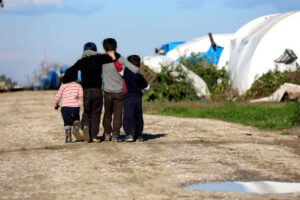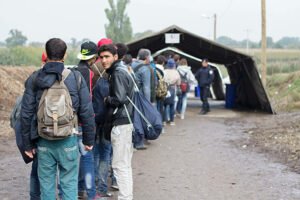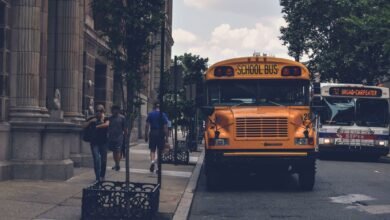NYC Migrant Crisis 2024 – Challenges and Solutions.

Uncover the complexities of the NYC Migrant Crisis, exacerbated by the existing housing shortage and driven by influxes from regions like Venezuela and Haiti. Explore the impact of initiatives like Governor Greg Abbott’s Operation Lone Star and Mayor Eric Adams’ executive orders, and learn about the ongoing efforts to address this pressing issue in the heart of the Big Apple.
The migrant housing crisis in New York City, stemming from the existing housing shortage, began in April 2022, exacerbated by the Venezuelan refugee crisis and other migrant influxes. Governor Greg Abbott’s Operation Lone Star, initiated in response to the CDC’s rescinding of Title 42 expulsions on April 1, 2022, has led to the busing of migrants from the Mexican border to Texas. While this free busing initiative doesn’t represent the majority of recent migrants, it does address many high-need cases, straining the city’s shelter system.
Controversy surrounds temporary shelters as Mayor Eric Adams seeks to modify the 1981 consent decree for Callahan v. Carey. President Biden’s extension of temporary protected status for Venezuelans in September 2023 aimed to reduce dependency by facilitating work permits. By July 2023, Mayor Adams warned of dwindling resources to accommodate the influx of approximately 100,000 migrants, stressing the city’s capacity limits.
By September 2023, Adams went further, cautioning that the migrant crisis could potentially “destroy” New York City. In response, on December 27, 2023, Adams issued an executive order mandating bus operators to provide 32 hours notice before dropping off migrants, requiring a passenger manifest, and limiting drop-offs to a designated site near Times Square during specific hours. This move inadvertently led to bus operators redirecting migrants to New Jersey train stations with tickets to New York City.

Causes and Origin of of the Nyc Migrant Crisis
1. Economic Disparities:
Many migrants are driven to NYC by economic factors. In their home countries, they may face poverty, lack of job opportunities, or inadequate wages. The promise of higher wages and better living standards in NYC acts as a powerful incentive for individuals seeking to improve their economic circumstances. This economic disparity is particularly pronounced in regions with high levels of unemployment, underemployment, or low wages, prompting individuals to migrate in search of better opportunities.
2. Political Instability and Conflict:
Political unrest, persecution, and conflict are significant drivers of migration to NYC. In regions plagued by instability, violence, or oppression, individuals and families may face threats to their safety and well-being. As a result, they may be forced to flee their homes and seek refuge in NYC, where they hope to find safety, stability, and protection from persecution.
3. Environmental Factors:
Climate change-related events, such as natural disasters, environmental degradation, droughts, and sea-level rise, can displace populations and lead to migration to urban centers like NYC. In areas vulnerable to the effects of climate change, such as coastal regions or regions prone to extreme weather events, individuals may be compelled to migrate to escape environmental hazards and secure their livelihoods.
4. Family Reunification:
Family reunification is a significant factor driving migration to NYC. Many migrants come to the city to reunite with family members who have previously migrated. Separation from loved ones due to migration or other circumstances can be a powerful motivator for individuals to seek to join their families in NYC, where they hope to rebuild their lives together.
5. Labor Demand:
NYC’s diverse economy and labor market offer employment opportunities across various sectors, including hospitality, construction, healthcare, retail, and services. The city’s robust economy and demand for labor often rely on migrant workers to fill job vacancies, particularly in industries facing labor shortages or requiring specialized skills. Migrants are drawn to NYC by the prospect of employment and the opportunity to earn higher wages to support themselves and their families.
6. Education and Opportunity:
NYC’s renowned educational institutions and cultural offerings attract students, scholars, and professionals from around the world. Many migrants come to the city seeking educational opportunities for themselves or their children, drawn by the prospect of access to high-quality education, research opportunities, and professional development. The city’s vibrant cultural scene and diverse communities also offer opportunities for personal and intellectual growth.
7. Globalization and Connectivity:
Increased globalization and connectivity have facilitated the movement of people, ideas, and resources across borders. Advances in technology, communication, and transportation have made it easier for individuals to migrate to NYC and other urban centers in search of better opportunities. Greater awareness of global trends, lifestyles, and opportunities has inspired individuals to seek new experiences and pursue their aspirations in cities like NYC.
8. Asylum and Refugee Status:
NYC has a long history of providing refuge to individuals fleeing persecution, violence, or threats to their safety in their home countries. Many migrants come to the city seeking asylum or refugee status, hoping to find protection and support as they rebuild their lives. NYC’s diverse immigrant communities and support networks play a crucial role in assisting asylum seekers and refugees in navigating the complex asylum process and accessing essential services.
9. Historical Factors:
NYC’s status as a global hub and melting pot of cultures is rooted in its history of immigration. For centuries, the city has welcomed migrants from around the world, drawn by the promise of freedom, opportunity, and a better life. Waves of immigration from Europe, Asia, Latin America, Africa, and the Caribbean have shaped the city’s identity and contributed to its cultural richness and diversity. This legacy continues to attract migrants to NYC, as they seek to be part of its dynamic and inclusive community.
10. Human Trafficking and Smuggling:
Sadly, some migrants are victims of human trafficking or smuggling networks, subjected to exploitation, abuse, and coercion as they are transported to NYC under exploitative conditions. Traffickers and smugglers prey on vulnerable individuals, deceiving or forcing them into situations of forced labor, sexual exploitation, or other forms of modern-day slavery. The clandestine nature of human trafficking and smuggling makes it difficult to quantify its extent, but it remains a pressing concern in efforts to address the migrant crisis in NYC and globally.
These explanations provide insight into the multifaceted nature of the causes and origins of the NYC migrant crisis, highlighting the complex interplay of economic, political, social, environmental, and historical factors driving migration to the city. Understanding these underlying dynamics is essential for developing effective strategies to address the challenges posed by the migrant crisis and support the well-being and integration of migrants in NYC.
Challenges Faced by Migrants Upon Arrival.
Upon arrival in NYC, migrants often encounter a range of challenges that can impact their well-being, integration, and ability to thrive in their new environment. Here are some of the key challenges faced by migrants upon arrival:
1. Legal Status and Documentation: Many migrants face challenges related to their legal status and documentation upon arrival in NYC. This includes issues such as obtaining visas, asylum or refugee status, work permits, and residency permits. Migrants without legal status may face barriers to accessing essential services, employment opportunities, and legal protections, leaving them vulnerable to exploitation and abuse.
2. Language Barriers: Language barriers can pose significant challenges for migrants, particularly those who are not proficient in English. Limited English proficiency can hinder migrants’ ability to communicate effectively, access information and services, and navigate daily life in NYC. This can lead to difficulties in accessing healthcare, education, employment, and social services, as well as social isolation and discrimination.
3. Housing and Accommodation: Securing safe, affordable housing is a major challenge for many migrants upon arrival in NYC. High housing costs, limited affordable housing options, and discrimination in the housing market can make it difficult for migrants to find suitable accommodation. Some migrants may end up in overcrowded or substandard housing conditions, facing housing instability and homelessness.
4. Employment and Economic Integration: Migrants often face barriers to employment and economic integration in NYC. This includes challenges such as lack of recognition of foreign qualifications and credentials, limited access to job opportunities that match their skills and experience, and discrimination in the labor market. Economic insecurity and unemployment can undermine migrants’ ability to support themselves and their families and may push them into low-wage, exploitative work.
5. Access to Healthcare: Accessing healthcare can be challenging for migrants, particularly those without health insurance or legal status. Migrants may encounter barriers such as lack of insurance coverage, language barriers, fear of deportation, and discrimination in healthcare settings. Limited access to preventive care, primary care, and specialized services can impact migrants’ health outcomes and well-being.
6. Education and Educational Opportunities: Migrant children and youth may face challenges in accessing quality education and educational opportunities in NYC. Language barriers, cultural differences, and lack of familiarity with the education system can hinder their academic progress and social integration. Migrants may also face discrimination and bullying in schools, further exacerbating their challenges.
7. Social Integration and Community Support: Social integration can be difficult for migrants, particularly those who are isolated from family and community networks. Migrants may experience feelings of loneliness, alienation, and cultural shock as they adjust to life in NYC. Building social connections, accessing community support services, and participating in cultural and social activities can help migrants establish a sense of belonging and connection in their new environment.
8. Legal and Immigration Issues: Migrants may encounter legal and immigration issues that affect their ability to remain in NYC and pursue their goals. This includes issues such as deportation proceedings, detention, detention, and family separation. Navigating the complex legal and immigration system can be daunting for migrants, particularly those without access to legal representation and support.
9. Discrimination and Xenophobia: Migrants may face discrimination, prejudice, and xenophobia in various aspects of life in NYC. This includes discrimination in housing, employment, education, healthcare, and social settings, as well as harassment, hate crimes, and stigmatization. Discrimination and xenophobia can negatively impact migrants’ mental health, well-being, and sense of safety and belonging in their new community.
10. Trauma and Mental Health Issues: Many migrants have experienced trauma, violence, and persecution in their home countries or during their journey to NYC. This includes experiences such as war, conflict, displacement, persecution, human trafficking, and exploitation. These experiences can have profound effects on migrants’ mental health and well-being, leading to symptoms such as anxiety, depression, post-traumatic stress disorder (PTSD), and other mental health issues.
Addressing these challenges requires a comprehensive and holistic approach that addresses the diverse needs and experiences of migrants and recognizes their contributions to NYC’s social, cultural, and economic fabric. Efforts to support migrants upon arrival should focus on promoting their rights, dignity, and well-being, as well as fostering inclusive and welcoming communities that embrace diversity and celebrate the contributions of migrants.

READ MORE: GrantWatch 2024 | Find Grants for Your Projects.
Impact of Migrant Crisis on Local Communities and Resources
The arrival of migrants in NYC can have both positive and negative impacts on local communities and resources, shaping social dynamics, economic opportunities, and the distribution of public services. Here’s an overview of the impact on local communities and resources:
1. Cultural Enrichment: Migrants bring diverse cultural traditions, languages, and perspectives to NYC, enriching the cultural fabric of local communities. They contribute to the city’s vibrant cultural scene through festivals, cuisine, art, music, and other forms of cultural expression. This cultural diversity fosters cross-cultural exchange, intercultural understanding, and appreciation for different ways of life, enhancing the social and cultural vibrancy of NYC.
2. Economic Contributions: Migrants play a vital role in NYC’s economy, contributing to various sectors such as hospitality, construction, healthcare, retail, and services. They fill essential roles in the labor market, often performing jobs that are low-paying, labor-intensive, or essential to key industries. Migrants’ labor and entrepreneurship stimulate economic growth, create jobs, and generate tax revenue, contributing to the overall prosperity of NYC.
3. Workforce Diversity and Innovation: Migrants bring a diverse range of skills, talents, and experiences to NYC’s workforce, driving innovation, creativity, and entrepreneurship. Their diverse perspectives and backgrounds enrich workplace dynamics, foster collaboration, and spur innovation and problem-solving. Migrants contribute to the city’s reputation as a global hub for innovation, attracting talent and investment from around the world.
4. Social Cohesion and Integration: Migrants contribute to social cohesion and integration in NYC by building bridges across diverse communities, fostering social connections, and promoting cross-cultural understanding and solidarity. They participate in community activities, volunteer initiatives, and civic engagement efforts, contributing to the social fabric of local neighborhoods and strengthening social bonds.
5. Pressure on Housing and Infrastructure: The influx of migrants can strain local housing markets and infrastructure in NYC, leading to increased demand for affordable housing, public transportation, schools, healthcare facilities, and other essential services. This pressure on housing and infrastructure can exacerbate existing challenges such as housing affordability, transportation congestion, and overcrowded schools, particularly in neighborhoods with high concentrations of migrants.
6. Access to Public Services: Migrants’ access to public services such as healthcare, education, and social services can vary depending on factors such as legal status, language proficiency, and cultural barriers. Increased demand for public services may strain resources and lead to longer wait times, reduced quality of care, and challenges in meeting the diverse needs of migrants and local residents alike.
7. Cultural and Linguistic Diversity: The presence of migrants in NYC contributes to the city’s cultural and linguistic diversity, creating opportunities for cross-cultural exchange, multicultural education, and language learning. However, linguistic diversity can also pose challenges in areas such as education, healthcare, and public services, where language barriers may hinder effective communication and access to information.
8. Community Tensions and Social Dynamics: The arrival of migrants can sometimes give rise to tensions and conflicts within local communities, particularly in areas experiencing rapid demographic change or economic restructuring. Competition for resources, cultural differences, perceptions of unfairness, and fears of social change or displacement can fuel social tensions and conflicts, highlighting the need for dialogue, community engagement, and conflict resolution efforts.
9. Community Empowerment and Resilience: Migrants often play active roles in community organizing, advocacy, and empowerment initiatives, mobilizing resources, building networks, and promoting social change. They contribute to community resilience by sharing skills, knowledge, and resources, addressing common challenges, and advocating for their rights and interests. Community-based organizations and grassroots initiatives led by migrants play a crucial role in addressing local needs and fostering community resilience.
10. Policy and Planning Considerations: The impact of migrants on local communities and resources underscores the importance of inclusive and equitable policies and planning strategies that address the diverse needs and experiences of migrants and local residents. Efforts to promote social inclusion, economic opportunity, and access to services should be informed by a deep understanding of the social, cultural, and economic dynamics shaping NYC’s diverse neighborhoods and communities.
The impact of migrants on local communities and resources in NYC is complex and multifaceted, reflecting the diverse contributions, challenges, and opportunities associated with migration. By recognizing and addressing these dynamics, policymakers, community leaders, and stakeholders can work together to foster inclusive, resilient, and thriving communities that embrace diversity and promote the well-being of all residents.
Solutions and Mitigation Strategies for NYC Migrant Crisis
Developing long-term solutions and mitigation strategies for the NYC migrant crisis requires a multifaceted approach that addresses the root causes of migration, promotes integration and inclusion, and ensures the well-being and rights of migrants. Here are some key strategies:
1. Addressing Root Causes: Work with international partners to address the root causes of migration, including political instability, conflict, persecution, poverty, inequality, and climate change. Support efforts to promote peace, stability, economic development, and environmental sustainability in migrants’ countries of origin.
2. Comprehensive Immigration Reform: Advocate for comprehensive immigration reform at the national level to create a fair, humane, and efficient immigration system that provides pathways to legal status and citizenship for undocumented immigrants, protects the rights of migrants, and addresses labor market needs.
3. Strengthening Legal Protections: Strengthen legal protections for migrants’ rights, including access to due process, legal representation, and protection from discrimination and exploitation. Ensure that migrants have access to information about their rights and avenues for seeking redress in cases of abuse or violation.
4. Investing in Education and Skills Development: Invest in education and skills development programs for migrants to enhance their opportunities for economic integration and social mobility. Provide language classes, vocational training, job placement services, and support for credential recognition to help migrants access employment and advance their careers.
5. Promoting Inclusive Economic Growth: Promote inclusive economic growth that benefits all residents, including migrants, by creating job opportunities, supporting small businesses and entrepreneurship, and addressing income inequality and disparities in access to resources and opportunities.
6. Expanding Access to Healthcare and Social Services: Expand access to healthcare and social services for migrants, regardless of immigration status. Ensure that migrants can access affordable healthcare, mental health services, housing assistance, education, legal aid, and other essential services to support their well-being and integration.
7. Building Affordable Housing: Increase the availability of affordable housing options for migrants and low-income residents to address housing insecurity and prevent homelessness. Invest in affordable housing developments, rental assistance programs, and tenant protections to ensure that all residents have access to safe and stable housing.
8. Fostering Social Cohesion and Inclusion: Foster social cohesion and inclusion by promoting dialogue, understanding, and collaboration among diverse communities. Support initiatives that bring together migrants and native-born residents to build connections, celebrate diversity, and address common challenges through community organizing, cultural exchange, and civic engagement.
9. Combatting Discrimination and Xenophobia: Combat discrimination, xenophobia, and hate crimes targeting migrants through public education campaigns, anti-discrimination laws, law enforcement training, and community-based initiatives. Promote messages of tolerance, acceptance, and respect for diversity to create a welcoming and inclusive environment for all residents.
10. Engaging Stakeholders and Collaboration: Engage stakeholders from government, NGOs, community organizations, businesses, academia, and migrant communities in collaborative efforts to develop and implement long-term solutions to the NYC migrant crisis. Foster partnerships, coordination, and knowledge sharing to maximize resources and expertise and ensure that interventions are effective and sustainable.
By implementing these long-term solutions and mitigation strategies, NYC can address the root causes of the migrant crisis, promote the well-being and integration of migrants, and build a more inclusive, resilient, and prosperous city for all residents.
Government and NGO Responses to the NYC Migrant Crisis: Collaborative Efforts for Support and Integration
As the influx of migrants to New York City (NYC) continues to pose significant challenges, both governmental agencies and non-governmental organizations (NGOs) have stepped up to address the multifaceted needs of this vulnerable population. Through collaborative efforts, these entities are striving to provide essential services, support integration, and advocate for the rights and well-being of migrants in the city.
Governmental Responses:
Governmental responses to the NYC migrant crisis involve a range of agencies at the local, state, and federal levels, each playing a role in addressing different aspects of the issue.
1. Local Government Initiatives: The NYC Mayor’s Office of Immigrant Affairs (MOIA) leads efforts to promote the integration and inclusion of immigrants and migrants in the city. MOIA works closely with community-based organizations, service providers, and advocacy groups to coordinate services, provide information and resources, and address barriers to access.
2. City Agencies and Services: Various city agencies, including the Department of Social Services (DSS), Department of Education (DOE), Department of Health and Mental Hygiene (DOHMH), and others, offer programs and services tailored to the needs of migrants. These services may include access to healthcare, education, housing assistance, legal support, language services, and job training.
3. Legal Aid and Immigration Services: Legal aid organizations and immigration service providers play a crucial role in providing legal assistance, advocacy, and representation to migrants facing immigration challenges. These organizations offer free or low-cost legal services, know-your-rights workshops, and support for asylum seekers, refugees, and undocumented immigrants.
NGO Responses:
NGOs and community-based organizations are at the forefront of providing direct assistance, support, and advocacy for migrants in NYC. These organizations operate a wide range of programs and services tailored to the diverse needs of migrant communities.
1. Direct Services and Support: NGOs provide a wide array of direct services to migrants, including food assistance, housing support, healthcare referrals, English language classes, job training, and legal assistance. These services aim to address immediate needs and empower migrants to navigate the complexities of life in NYC.
2. Community Outreach and Education: NGOs engage in community outreach and education efforts to raise awareness about migrants’ rights, available services, and resources. They conduct workshops, informational sessions, and outreach events to connect with migrant communities, build trust, and provide accurate information.
3. Advocacy and Policy Reform: NGOs advocate for policy reform and systemic change to address the root causes of the migrant crisis and improve conditions for migrants in NYC. They work to advance immigrant-friendly policies, protect human rights, and combat discrimination, xenophobia, and anti-immigrant rhetoric.
Collaborative Efforts:
Governmental agencies and NGOs collaborate closely to leverage their respective strengths and resources in responding to the NYC migrant crisis.
1. Partnerships and Coordination: Governmental agencies and NGOs form partnerships and collaborative networks to streamline service delivery, share information, and coordinate responses. These partnerships enable more efficient use of resources and enhance the effectiveness of interventions.
2. Capacity Building and Training: NGOs collaborate with governmental agencies to build the capacity of frontline staff, service providers, and volunteers working with migrant populations. Training programs cover topics such as cultural competency, trauma-informed care, legal rights, and language access, ensuring that services are delivered in a sensitive and effective manner.
3. Data Sharing and Research: Governmental agencies and NGOs collaborate on data collection, research, and analysis to better understand the needs, experiences, and outcomes of migrants in NYC. By sharing data and insights, they can identify gaps in services, track trends over time, and inform evidence-based policymaking and program development.
In response to the NYC migrant crisis, governmental agencies and NGOs are working together to provide essential services, support integration, and advocate for the rights and well-being of migrants in the city. Through collaborative efforts, these entities are striving to address the diverse needs of migrant communities and create a more inclusive and welcoming environment for all residents of NYC.
Economic Implications for NYC
The influx of migrants to New York City (NYC) carries significant economic implications, shaping various aspects of the city’s economy, labor market, and fiscal landscape. Here are some of the key economic implications for NYC:
1. Labor Force and Workforce Dynamics:
Migrants contribute to NYC’s labor force, filling essential roles in various sectors such as hospitality, construction, healthcare, retail, and services. They bring diverse skills, talents, and experiences to the workforce, helping to meet the demand for labor and fill job vacancies. Migrants often perform jobs that are low-paying, labor-intensive, or essential to key industries, supporting economic growth and productivity in NYC.
2. Economic Growth and Innovation:
Migrants play a vital role in driving economic growth and innovation in NYC. Their entrepreneurial spirit, creativity, and ambition contribute to the dynamism and resilience of the city’s economy. Migrant-owned businesses and startups contribute to job creation, innovation, and diversification of industries, helping to sustain NYC’s position as a global economic hub.
3. Consumer Spending and Market Demand:
Migrants contribute to consumer spending and market demand in NYC, supporting local businesses, retail establishments, and consumer-oriented industries. Their purchasing power stimulates economic activity and drives demand for goods and services, ranging from food and clothing to housing and entertainment. Migrants’ consumption patterns and preferences shape market trends and influence the urban economy.
4. Tax Revenue and Fiscal Impact:
Migrants contribute to tax revenue and fiscal resources in NYC through various channels, including income taxes, sales taxes, property taxes, and business taxes. Their economic activities generate revenue for local, state, and federal governments, supporting public services, infrastructure development, and social programs. However, the fiscal impact of migration may vary depending on factors such as migrants’ income levels, employment status, and access to public benefits.
5. Housing Market Dynamics:
The influx of migrants can impact the housing market in NYC, affecting housing affordability, supply, and demand. Migrants may compete for housing in certain neighborhoods, driving up rents and home prices, particularly in areas with high concentrations of migrants or limited affordable housing options. This can pose challenges for low-income residents and exacerbate housing inequality and gentrification pressures.
6. Labor Market Dynamics and Wage Trends:
Migrants’ participation in the labor market can influence wage trends, labor market dynamics, and employment conditions in NYC. Migrants may accept lower wages or less favorable working conditions compared to native-born workers, leading to concerns about labor market competition and downward pressure on wages in certain industries. However, migrants also contribute to labor market flexibility, filling critical roles and supporting economic sectors facing labor shortages.
7. Social Services and Public Spending:
Migrants may access social services and public benefits in NYC, including healthcare, education, housing assistance, and social welfare programs. The provision of these services incurs costs for local governments and taxpayers, impacting public spending priorities and budget allocations. The economic integration of migrants, their access to employment opportunities, and their contributions to tax revenue influence the fiscal balance of social services and public programs.
8. Global Talent and Human Capital:
NYC’s attractiveness to migrants as a global destination for talent and human capital enhances the city’s competitiveness and innovation capacity. Migrants bring diverse skills, knowledge, and expertise to the city’s workforce, contributing to its status as a leading center for business, finance, technology, arts, and culture. The presence of a diverse and skilled migrant workforce strengthens NYC’s position in the global economy and fosters collaboration, creativity, and exchange across industries.
The economic implications of migration for NYC are complex and multifaceted, reflecting the diverse contributions, challenges, and opportunities associated with the influx of migrants to the city. By leveraging the talents and energies of migrants, addressing their needs and aspirations, and promoting inclusive economic growth, NYC can harness t

s of society. As
essential for supporting migrants upon arrival, addressing their immediate needs, and promoting their integration and empowerment in NYC.
By embracing diversity, combating discrimination and xenophobia, and investing in social services, education, healthcare, and economic opportunities, NYC can transform the migrant crisis into an opportunity for growth, resilience, and solidarity. Together, we can create a city where all residents, regardless of their background or immigration status, can thrive and contribute to the vibrant tapestry of NYC’s cultural and economic life.
Frequently Asked Questions about the NYC Migrant Crisis
1. What is the NYC migrant crisis?
– The NYC migrant crisis refers to the influx of migrants, including asylum seekers, refugees, and undocumented immigrants, arriving in New York City in search of safety, opportunity, and a better life. It encompasses a range of challenges and issues related to immigration, integration, and the provision of services and support for migrant communities.
2. What are the main causes of the NYC migrant crisis?
– The NYC migrant crisis is driven by various factors, including political instability, conflict, persecution, economic disparities, environmental challenges, and family reunification. These factors compel individuals and families to leave their home countries and seek refuge or opportunities in NYC.
3. How is the NYC migrant crisis impacting local communities and resources?
– The NYC migrant crisis has diverse impacts on local communities and resources, including pressure on housing and infrastructure, strains on social services and public resources, cultural enrichment, economic contributions, and social cohesion challenges.
4. What are the challenges faced by migrants upon arrival in NYC?
– Migrants face a range of challenges upon arrival in NYC, including legal status issues, language barriers, housing insecurity, barriers to employment and economic integration, access to healthcare and education, discrimination, and trauma-related mental health issues.
5. What is the government’s response to the NYC migrant crisis?
– The government’s response to the NYC migrant crisis involves various agencies at the local, state, and federal levels, providing services, support, and advocacy for migrants. This includes agencies such as the Mayor’s Office of Immigrant Affairs, city departments, legal aid organizations, and immigration service providers.
6. What role do NGOs play in addressing the NYC migrant crisis?
– NGOs and community-based organizations play a crucial role in providing direct services, support, and advocacy for migrants in NYC. They offer a wide array of programs and initiatives tailored to the diverse needs of migrant communities, including legal assistance, social services, education, healthcare, and community empowerment efforts.
7. How can individuals and communities support migrants affected by the crisis?
– Individuals and communities can support migrants affected by the crisis by volunteering with local NGOs, advocating for migrant rights and inclusion, offering language and cultural support, providing donations or resources, and fostering welcoming and inclusive environments for all residents.


